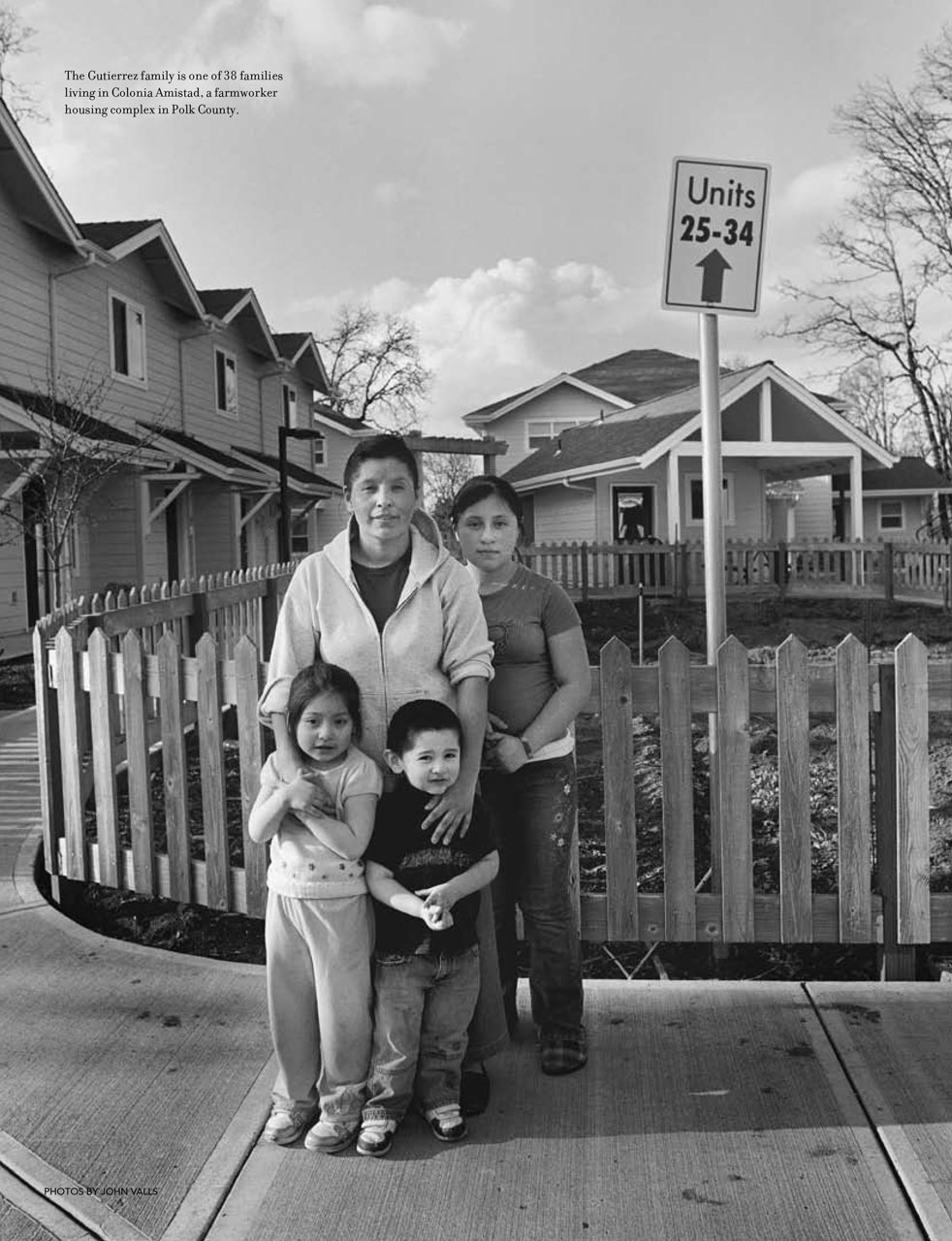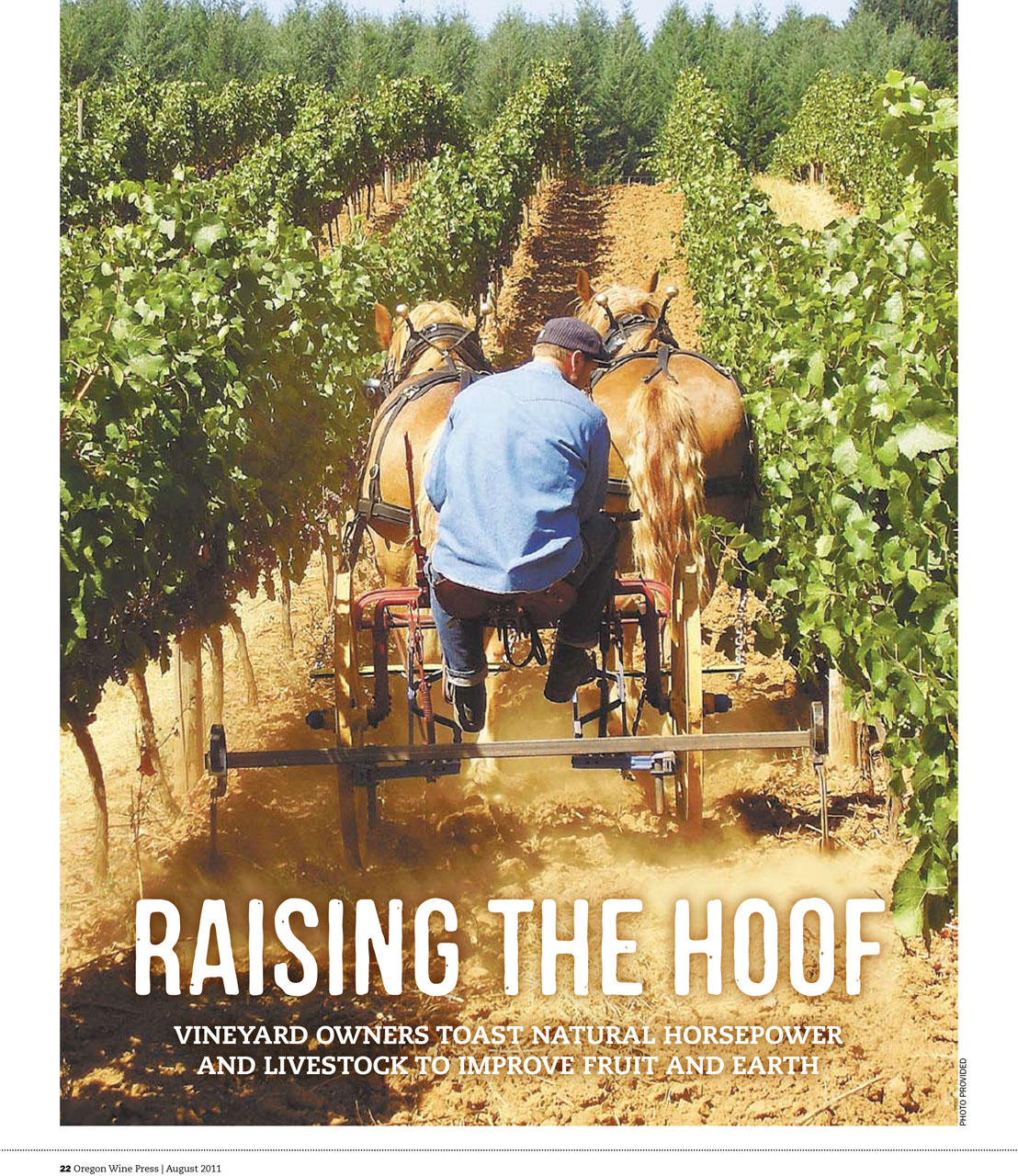A Roof is not Enough: Two Oregon Nonprofits help to build community by providing safe and affordable in-town housing for farmworkers

Two Oregon nonprofits help to build community by providing safe and affordable in-town housing for farmworkers
Reynaldo Robles is a retired Oregon farmworker. His eyes crinkle to the roots of his salt-and-pepper hair. A neatly trimmed moustache trembles when he laughs. When he speaks, he punctuates the air with his hands while a torrent of Spanish words surge like an undammed river. He pauses only to make sure Jaime Arredondo, acting as translator, can keep up. Robles harvested fruits and vegetables in the mid-Willamette Valley for more than 40 years. Five years ago, he retired when he was diagnosed with lung cancer. At the age of 73, he is one of the most active residents in his new community. Like many farmworkers, Robles spent decades dwelling in substandard, overcrowded, unsanitary housing.
Oregon has the sixth largest farmworker population in the country, with 95,505 seasonal workers counted by the 2002 census. This number does not include contract labor or the families of the workers. Farmers have traditionally provided housing for their workers in labor camps. Many of the camps in Oregon, built in the 1940s, were intended for single men and are not suitable for families with children. The cost of providing and maintaining this housing, plus increased government regulations, discourage already financially stressed modern farmers from building new housing, and the number of registered labor camps is steadily decreasing.
The Oregon Occupational and Safety Health Division (OSHA) reported 356 registered farmworker camps that housed 11,916 workers in 2004 (approximately 13 percent of the estimated population). Farmworkers who do not reside in OSHA registered camps are forced to compete with other low-income populations for local housing. According to interviews conducted by the League of Women Voters and Oregon Housing and Community Services, most farmworkers cannot afford the market-rate rents, rental deposits and other costs associated with private housing. Finding short-term housing is unfeasible. Language and cultural barriers further convolute the process, as does the seasonal cycle of the work.
The League of Women Voters also reported on the prevalence of unregistered camps. The number is unknown, but estimated to be as high as twice the number of registered camps. In some cases, farmworkers are living in barn stalls or run-down trailers without sewage or septic systems. “It’s an invisible population,” says Karen Shawcross, the Executive Director of Bienestar, a housing development corporation serving low-income families in Washington County. Farmworkers live in isolation, often planting, cultivating, harvesting and sleeping in the same spot, far from community services.
“When I say that the farmworker population is invisible, it truly is,” continues Shawcross. “They used to camp along the railroad tracks in Cornelius, until the sheriff and the police drove them out. They camp out in the fields; they live in their cars.” Despite the size of their population, most people never see them and aren’t aware they exist.
A stone’s throw from the Woodburn Shopping Outlet Center, a top tourist destination for the state visited by close to four million people annually, migrant camps that are still in use sit in decay. A row of duplexes, each equipped with six to eight scrawny metal bunks, will sleep 30.
The concrete floors where many of the occupants sleep are dirty. Stained sheets hang haphazardly as makeshift curtains. The kitchen consists of rusty appliances and a grimy table. A mustard-yellow fridge tilts against the outside of a unit, resting in a puddle of mud. Some of the camps have no indoor plumbing—neither sinks, toilets, nor showers. This one does have a bathroom, but you wouldn’t want to venture in. Rusted white metal posts lassoed with a thick wiry cord circle the camp. Is this resurrected fence to keep workers in, or outsiders away?
Oregon legislators have stated that “the availability of affordable, decent, safe and sanitary housing opportunities for persons of lower, middle and fixed income, including housing for farm workers, is a matter of statewide concern.” Immigration reform and sustainable local food dominate the headlines, but farmworker housing still vexes the industry.
Nonprofit organizations acting as housing developers have taken up the cause. Two of the most active organizations, Bienestar and the Farmworker Housing Development Corporation, are finding success in their efforts to provide safe and affordable in-town housing for yearround farmworkers in Oregon.
Bienestar evolved from a local nonprofit in 1981 in response to the alarming conditions of migrant farmworker housing camps in Washington County. Elm Park Apartments, built in Forest Grove in 1984 and 1988, was their first farmworker community. The 62-unit development includes 10 units for seasonal migrant workers. Though a victory overall, the community was constructed only after hard-fought political battles to overcome NIMBY (“not in my backyard”) contention.
In response to the initial proposal, Forest Grove amended an ordinance in order to prohibit farmworker housing within city limits. After taking the issue to the Oregon Court of Appeals and winning, the organization was able to move forward with the development.
Today, Bienestar manages ten properties—nine in Washington County and one in Columbia County—which house 458 families, most of whom are Mexican immigrants. Seven of the properties are designated for farmworkers.
“I recently heard on National Public Radio that a person in Haiti [before the earthquake] lived on $2 per day,” says Shawcross. Soon after, she was compiling statistics for their Montebello apartments in Hillsboro, where the average family size is five people. Fifty-three percent of the residents reported an annual income of less than $20,000. Thirty-eight percent had incomes below $10,000. “That meant our residents were living on $2.47 per day as individuals or $5.40 as families,” she says.
Housing costs in Washington County are among the highest in Oregon. “We have waiting lists at all of our farmworker properties and our occupancy has run for years at 100 percent.”
Though the initial draw is financial, families stay for the community. All of the housing developments operate under a holistic philosophy. “We’ve always felt that it was about more than just providing bricks and mortar housing for families,” says Shawcross. “Resident service programs have always been a critical component, and over the past two and a half years we’ve ramped up those programs like crazy.”
Regular programs include GED prep classes, computer and financial literacy training, community gardens, a matched savings program, a microenterprise program and counseling services. The microenterprise program offers residents training in the fall and winter on organic microfarming techniques and running a small business. They then receive a plot of land where they can grow organic produce and a free slot at the Forest Grove Farmers’ Market.
“We hope to develop a new 24-unit farmworker housing complex project in Forest Grove starting at the end of this year,” Shawcross says.
The city manager of Forest Grove wrote a letter of support for the proposed development, Juniper Gardens Apartments. “I think that is a wonderful testimonial to the success and integration into a community after the original battle in 1983,” says Shawcross.
To the south, the Farmworker Housing Development Corporation (FHDC), based in Woodburn, is a communitybased nonprofit organization dedicated to serving farmworkers and their families in the mid-Willamette Valley.
FHDC manages a total of 190 units in Woodburn, Salem and Independence, providing housing to almost 200 families, or 1,000 individuals. All the properties require that at least 55 percent of the annual income of residents is from farm work.
Woodburn lies at the heart of one of Oregon’s richest agricultural regions and has been dependent on Latino farmworkers since the 1940s. The 2000 census found Woodburn to be the largest Oregon city that has a majority population of Latinos.
Although the regional economy exists due to farmworker labor, living conditions at the farmworker camps, like in Washington County, have been appalling and substandard. At the same time, demand for low-income farmworkers has increased with the expansion of the nursery industry and a longer growing season creating year-round jobs. Historically, affordable housing has been like a needle in a haystack.
A coalition of farmworker advocacy groups banded together to form FHDC in 1990 in response to the crisis, establishing a single agency for the development of affordable housing for low-income farmworkers.
“We wanted to build housing that was family oriented,” says Jaime Arredondo, the Fund Development Director for FHDC. Arredondo is originally from the Mexican state of Michoacán. He grew up in a farmworker family in Salem and went on to graduate from Willamette University.
FHDC employs about 26 staff, close to 95 percent of whom are former farmworkers or have a background in farmwork.
“We understand the needs of our population,” Arredondo explains. “We’ve been through the same struggles as our families. I think this allows us to serve people to a greater standard.”
Their first community, Nuevo Amanecer (New Dawn), which was built in 1994, was the first federal-tax-credit low-income farmworker housing project in the nation. “It was a very uphill battle,” says Arredondo.
Plans for the development were met with fierce opposition from a handful of community leaders who did not want the farmworkers to integrate. The day construction was to begin, two signs sat at the site. One read: “Go Home.” The other: “Woodburn’s Next Ghetto.” Governor Barbara Roberts, a staunch advocate of FHDC, stepped into the tangled politics and made sure the project began as planned.
“A lot of it is trying to change people’s perspective,” says Arredondo.
Nuevo Amanecer is an idyllic property, lauded as an exemplary farmworker community. The earth-tone housing complex is made up of 92 apartments, all framed with elegant landscaping. Schools, grocery stores and medical facilities are all within walking distance. Over the years, as the need for farmworker housing has grown, the apartment complex has expanded and now provides homes to almost 100 families. The most recent addition is a community garden tended by residents.
The second development built by the FHDC is Esperanza (Hope) Court, a complex of twelve two-bedroom apartments that opened in 1999, also in downtown Woodburn. Despite the success of Nuevo Amanecer, the FHDC faced strong opposition again from city officials. This time, however, they had support from the surrounding community. More than 750 local residents signed petitions supporting the complex, and many businesses wrote letters of support. Late into the night at the last hearing of the city commission, one former farmworker stood up, remembers Arredondo. He turned to the crowd and said: Think about where you will sleep when you go home tonight. Now think about where these farmworkers will sleep.
The city commission approved the plans for Esperanza Court. “Now we have a phenomenal relationship in that community,” says Arredondo. “The people that were in opposition of us are some of our biggest supporters at this point.”
In 2002, FHDC was seeking funds to build a community center on the grounds of Nuevo Amanecer. The City of Woodburn stepped in to provide funding through a Community Development Block Grant. “That’s the kind of change that we’ve seen,” says Arredondo.
The community centers are an integral component to each housing complex, offering a place for gathering and celebrations and hosting an array of social services, educational programs and leadership development.
“A Roof is Not Enough—that is our operating philosophy,” says Arredondo.
Like Bienestar, FHDC has a Resident Association program, with resident-elected officers for each property. “We’ve seen that by engaging folks in the decision making, people take greater pride in taking care of their home.” Arredondo pauses, and then adds, “We want everyone to have a voice.”
FHDC collaborates with the local school districts to provide after-school programs and partners with higher education institutions like Chemeketa Community College, Willamette University and Tokyo International University of America.
“Our high school graduation rates are over 90 percent. You put that into perspective with the national and state percentage of Latinos graduating and it’s extremely high,” says Arredondo. He credits the success to safe homes, supportive services and involved parents.
The FHDC housing complexes are a success story, but one with weighted perspective. It’s taken more than twenty years for the FHDC to build the 190 units. The number of farmworkers in Marion and Polk counties is close to 30,000. “We are just scratching the surface in terms of the demand that is out there for farmworker housing,” says Arredondo.
Labor leader and civil rights activist César Chávez once said, “The fight is never about grapes or lettuce. It is always about people.” When bringing the politics of food to the table, Roberto Jiménez, the executive director of FHDC, notes, “I think the first thing people think about with food is whether it’s organic or not. That’s an easy distinction for people to make. I also think that people think about whether it’s local or not. But I don’t think they think about who is harvesting it. That’s the issue.”
Jiménez sees a budding movement around the social justice aspect of food production. “Overall, I feel positive about the direction we are going. I’m a huge believer in people’s capacity to change. I say that on both sides. I say that for farmworkers and for those who are opposed to what we do.”
FHDC receives visitors from all over the state intrigued by their model. “People are drawn to the farmworker story,” says Arredondo. “It’s not enough to go out and talk about it and show pictures,” he says. “You really have to see it for yourself. What we’ve seen is, when you give people a taste of things, they really do want to know more.”
The most recent tour included a cadre of architecture students from the University of Oregon. Their takeaway assignment: To design modular homes with the farmworker in mind, focusing on quality, efficiency and economics.
“I’m impressed daily with the capacity for change amongst farmworkers that I see and their upward mobility,” says Jiménez. “I’m incredibly impressed with the communities that we go into where we see strong opposition and the ability of people to turn around and say, ‘I misunderstood—I thought it was something else.’ We see that all the time.”
Reynaldo Robles, the gregarious retired Oregon farmworker, completes the story. The sleepless nights at labor camps may haunt his past, but as an eleven-year resident of Nuevo Amanecer, he’s found a place to call home.
Edible Portland | Summer 2010
Click here to read the article on the Edible Portland website http://edibleportland.com/a-roof-is-not-enough/.





